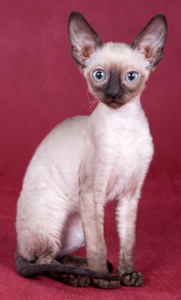|
The Scratching Post
Cornish Rex 
The Cornish Rex is a strange-looking cat with an extremely soft and wavy coat. The head is small and egg-shaped. The large ears are set high on the small head and are erect and alert. The body is small to medium in size. The short, racy body has an arched back and a tuck-up, much like the style seen in the Greyhound or Whippet dogs. It has dainty, oval paws and a long, slender tail that tapers towards the end and is extremely flexible. A kinked or abnormal tail or any signs of poor health are causes for disqualification.
|
|
Temperament
|
The Cornish Rex is gentle, friendly, athletic and makes a good family pet. They enjoy being around people and other animals. Some say that the Cornish is a lap cat while others say it just likes to be cuddled. They bond to the whole family and are a vocal breed.
|
|
Weight
|
7-9 lbs.
|
|
Health Problems
|
The Cornish Rex is somewhat fragile because of its delicate coat. Besides its weather sensibilities, it is a generally healthy cat with a long life span.
|
|
Living Conditions
|
This breed does not do well in extreme weather conditions. Keep them away from extreme heat and provide extra warmth on cold days. They enjoy being indoors and do well in an apartment.
|
|
Exercise
|
This is an active and playful breed. They enjoy playing and should be provided with toys and a scratching post.
|
|
Life Expectancy
|
About 10-14 years
|
|
Grooming
|
The Cornish requires very little grooming. Care should be taken not to brush the coat too hard as they may develop bald spots. Firm stroking of the coat can promote the wavy pattern.
|
|
Origin
|
The Cornish Rex originated from a genetic mutation in a litter of regular farm cats born on July 21, 1950 in Cornwall, England. The first Cornish Rex was named Kallibunker and his mother was Serena. He was a cream-colored, curly-coated male. This kitten was different from his littermates in that his coat was short and curly and his body long and lithe. He had large ears, a slender tail and an egg-shaped head. The owner, Mrs. Nina Ennismore, bred Kallibunker with his mother, which produced two more curly coated kittens. Continued breeding established the Cornish Rex breed. The name Cornish Rex was decided upon because of the breed?s origin in Cornwall and its resemblance to the Astrex rabbit.
|